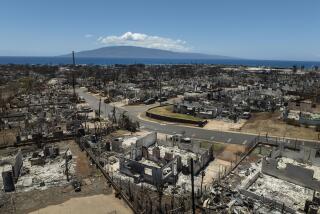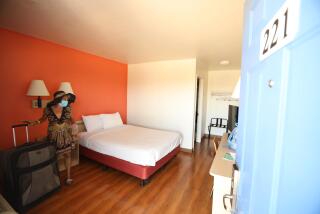Quake Victims to Get Reprieve on U.S. Rent Aid
- Share via
Thousands of low-income families and individuals driven from their homes by Northridge quake damage are receiving word this week that the federal government will cover most of their rent indefinitely, granting them a reprieve from the scheduled end of assistance payments and underscoring the disaster’s continuing affect on the poor.
Notices now in the mail end a roller coaster ride of uncertainty for many of the 7,200 displaced residents, who faced an end to the special subsidies on June 30.
The action marks the third time since the Jan. 17, 1994, temblor that the government has extended the program just before its scheduled termination.
Sandra Juarez, 44, of Van Nuys was among those heartened that she will continue to receive aid under the program for low-income recipients whose residences were destroyed by the quake or condemned because of quake damage.
“I was living on the edge and didn’t know when I was going to fall off,” said Juarez, who lost the two-bedroom Hollywood apartment she shared with her three children.
“I lost everything and [the assistance] was giving me an opportunity to regroup.”
The special program for quake victims helped those who were already on waiting lists for Section 8 housing aid from the federal government, or those who qualified for the program because of quake damage to their homes.
Under the program, the federal Department of Housing and Urban Development pays 70% of the rent for recipients who meet the income provisions. A family of four would need an income of less than $26,000 a year to qualify, said George McQuade, a spokesman for the Los Angeles Housing Authority, which administers the HUD assistance.
But the actual average annual income of a family of four now receiving the quake-related aid is $13,313, he said.
Usually, HUD has only enough money to provide Section 8 aid to about 10% of qualified applicants. The special quake-aid provision jumped victims ahead on HUD’s eligibility list, qualifying them for immediate help, but the aid was originally intended to be temporary. The program was initially scheduled to end last June, then Dec. 31, and finally was extended to June 30.
But when Congress passed HUD’s budget last month, it merged the earthquake-related subsidies into the regular Section 8 program, eliminating the temporary nature of the aid.
At the high point of the quake program, about 12,900 families and individuals were receiving aid, said Jacquelyn Slayton, area coordinator for the Los Angeles HUD office. Nearly half of them have since become sufficiently self-supporting to leave the program, and recipients continue to leave at a rate of about 30 per week, Slayton said.
Jeff Farber, director of social services for the Los Angeles Family Housing Corp. in North Hollywood, a private agency that has provided counseling for some displaced families, said a June 1995 decision to extend the special Section 8 program for six months could have caused some of those then in the program to postpone getting off the program.
But given the limited number of people still left on the program, he said, no such danger exists today.
“The message being sent here is not to get on assistance and stay on assistance. It’s one that recognizes some people are just not able to pick themselves up,” he said.
Juarez said that after the quake, she and her children stayed at a Federal Emergency Management Agency shelter, then moved in with the children’s godfather in East Los Angeles. That forced her to quit her telemarketing job because she could no longer reach the office without a car, she said.
Since then, she has worked the odd jobs that her high school education qualifies her for and was helped by a teenage daughter and son who recently began to work.
But caring for her youngest child, a 9-year-old boy, has slowed her efforts. She has often quit or worked only part time because she could not find a baby-sitter, she said.
“We lost everything but the clothes on our backs,” she said during a day off from her most recent job, a minimum-wage position at AT&T.; “That’s not easy to recover from.”
The Van Nuys apartment that Beth Barnett, 44, shared with her two youngest children was destroyed by the quake. She said for nearly three months after the disaster she and the girls, ages 8 and 10, lived in her old complex’s parking lot, a FEMA shelter and a public park.
“We were like a rolling stone. Wherever we could lay our hats was our home,” said Barnett, who has had six children since her first was born when she was 15. “We were homeless.”
She said HUD eventually found her a two-bedroom apartment on the same block as her old place but that it has a cockroach problem. “They’re everywhere. We have to brush them off in our sleep,” she said.
More to Read
Sign up for Essential California
The most important California stories and recommendations in your inbox every morning.
You may occasionally receive promotional content from the Los Angeles Times.













